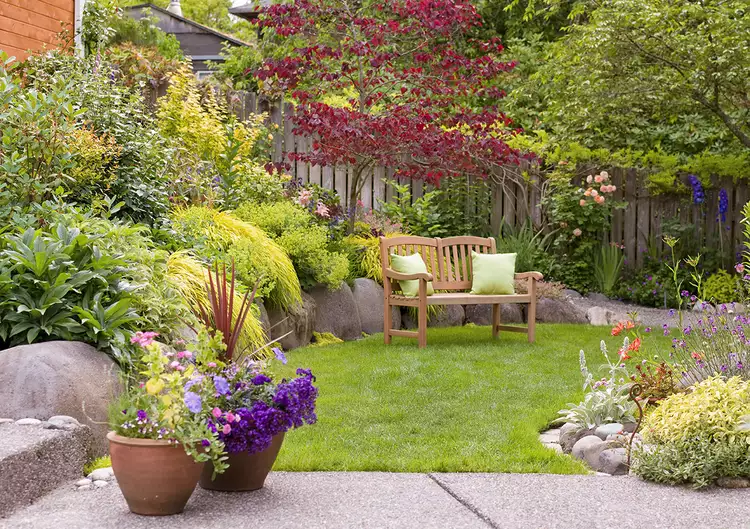Gardening on a slope can seem like a challenge, but hilly or sloped areas of your yard are perfect for creating terraced flower beds, rock gardens, and more. These slope garden design ideas will help you use uneven terrain to your advantage.
Create a Wall of Flowers
A retaining wall is great for a hillside flower bed because it creates planting opportunities when you select construction materials that allow you to plant in nooks and crannies along the wall's surfaces. Sedums spill from spaces in a 4-foot-tall retaining wall made of dry-stacked salvaged concrete.
Test Garden Tip: Other crevice-loving plants include creeping phlox, rock cress, thyme, hens-and-chicks, sweet alyssum, trailing lobelia, snow-in-summer, and candytuft.
Just Add Water
A backyard waterfall is the ultimate way to take advantage of planting on a slope. A steep slope is an opportunity to create a dramatic, sheer curtain of water. You'll need electricity nearby to bring life to the water pump but an electrician should be able to help provide the power.
Display Your Favorite Containers
Take advantage of a change in grade to display your favorite potted plants on the outer edges of a sloped flower bed. Place a variety of container gardens in well-traveled areas, such as entries, gives them greater impact.
Build a Stairway
Connect two levels with a curving stairway that minimizes the severity of the sloped flower bed. Drought-resistant groundcovers and succulents that thrive in hot weather can prevent erosion on steep grades and make the journey more interesting.
Terrace It
If one big wall won't do, several low walls with level terraces between may be the right solution. Consider paving a level to build a patio and a comfy outdoor seating area. A sloped backyard design creates an inviting patio, a great place to sit and survey the rest of your garden.
Grow Natives
Rocks and naturalistic plantings turn an eroding California hillside flower bed into a colorful oasis that blends with the surrounding desert habitat. Low-maintenance succulents such as Agave, Crassula, and Bulbine thrive here. Other good candidates for a dry hillside include Pennisetum, salvia, yarrow, and lamb's ear.
Plant It
Plant roots are very efficient at anchoring loose soil on a sloped flower bed. So turn a tough hillside flower bed into a beautiful planting by selecting easy-care groundcover plants for slopes that root into the bank wherever their stems touch soil. The dense mats that groundcover plant roots create will reduce erosion and weeds.
Deck the Hill
Transform a steep sloped flower bed into valuable living space by straddling it with a multilevel deck. The contrast between natural plantings and a deck is always striking.
Test Garden Tip: Up the drama by building around an existing tree or planting one near the deck.
Make a Boulder Statement
Nestle clusters of boulders into the soil. They anchor portions of the sloped flower bed and add natural beauty. Arrange rocks into groups staggered informally for a natural look. Bury the bottom one-third to one-half of each large rock to stabilize it. Pack soil firmly around the rocks, and finish with plantings.
Step It Up
Steps convert a sloped flower bed from inaccessible to inviting. Wide steps that meander or zigzag up a steep slope are easier to climb than those that escalate rapidly.
Test Garden Tip: Begin building at the base of your sloped flower bed if you're not sure where to add your stairs. Try climbing the slope along several different paths until you find the most comfortable route.
Build a Babbling Brook
A shallow slope is the perfect site for a burbling stream. Water can cascade down slopes that once seemed unmanageable while controlling erosion and managing moisture levels. Creating a dry creek or stream bed also works if you don't have a water source.
Connect Activity Areas
A dry-stack stone wall and mortared stone steps join a small pool house and spa set at different levels in the landscape. Lush plants for slopes soften the hardscape, add color and fragrance, and invite exploration.
Create a Tiered Vertical Garden
An abundance of spring bloomers turns towering terraces into a crazy quilt of cottage charm. Follow spring bulbs with summer- and fall-blooming perennials for extended bloom and season-long color. A few trailing plants spilling over the edges will enhance the naturalistic look.
Elevate Outdoor Living Spaces
Nestle an outdoor living space into your hillside flower beds. Steps to a raised flagstone patio provide the perfect view to the rest of the garden, while a pergola provides privacy. A trickling stream with a series of cascades creates soothing sounds for relaxation.
Weave a Textural Tapestry
Create a sweeping swath of groundcover plants for a low-maintenance slope solution. Most need trimming only once per year so you can almost literally plant them and forget them.
Create a Private Getaway
Colorful perennials and shrubs turn a utilitarian rock wall into a beautiful, naturalistic feature above an intimate retreat for two. Boulders support a border that includes Forest Pansy redbud, cascading Japanese forest grass, and lady's mantle.
Garden Room Galleries
Take advantage of a long slope by dividing it into different levels. Here, wide terraces create planting spaces for individual garden rooms on each level. Stone steps allow for easy access between levels.
Box It In
Use a slope to create garden art! Here, boxwood hedges create a visual masterpiece on a slope. The blue fescue between the hedges adds a pretty contrast in form and color. Planting on the slope enables you to view the distinct planting pattern while enjoying a meal on the patio.




















